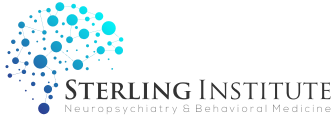Ketamine Therapy
Call: (475) 329 2686Telehealth Ketamine Therapy
In the evolving landscape of mental health treatment, the Sterling Institute of Neuropsychiatry & Behavioral Medicine stands at the forefront, offering cutting-edge therapies and accessible telehealth services that provide hope and healing to individuals struggling with various mental health conditions. Among our most innovative treatments is intranasal ketamine therapy, a rapidly emerging solution particularly effective for conditions that have proven resistant to traditional therapies. Sterling Institute offers online mental health treatment services, including ketamine therapy, to individuals in various states, including Arizona, Connecticut, New York, Massachusetts, Michigan, and Florida. We also provide international psychiatric services via telehealth.


What is Ketamine Therapy?
Ketamine therapy involves the medical use of ketamine, an anesthetic that has been safely used in clinical settings for decades. Recently, it has garnered significant attention for its powerful and rapid effects on various mental health conditions and mood disorders. When administered in low doses, ketamine influences the brain's glutamate system, crucial for regulating mood and cognitive function.
Ketamine treatment is particularly effective for individuals suffering from conditions such as treatment-resistant depression, severe anxiety, PTSD, and bipolar disorder. Unlike traditional antidepressants, which may take several weeks or even months to show significant effects, ketamine therapy often provides relief within hours or days. This swift action can be life-changing for patients who have struggled to find effective treatments through conventional methods.
Methods of Administration
Ketamine can be administered in several ways with different benefits and considerations. Here are some of the most common methods of ketamine administration:
- Intravenous (IV) infusion: This method involves administering ketamine directly into the bloodstream through an IV. This is a more invasive method often used in hospitals, specialized ketamine clinics, and other inpatient facilities. IV infusions provide a rapid onset of effects and may be used to treat acute suicidal ideation or chronic pain.
- Oral and sublingual (under the tongue): These methods involve taking ketamine in pill form or as a tablet. This method of administration is most commonly used at home with a prescription from a psychiatrist at a private practice or outpatient mental health center. While oral and sublingual ketamine administration is convenient, it may have slower and less predictable absorption rates.
- Intranasal (nasal spray): Intranasal ketamine is administered through the nasal passages, allowing quick and efficient absorption with minimal invasiveness and rapid symptom relief. At Sterling Institute, intranasal ketamine can be prescribed as one of our psychiatric services through telehealth, making effective treatment easily accessible, regardless of location.
Related: Intranasal Ketamine for Depression At Sterling Institute
How Does Ketamine Work?
Ketamine's effectiveness in treating mood disorders lies in its unique action on the brain's glutamate system. Specifically, ketamine blocks the N-methyl-D-aspartate (NMDA) receptor, a critical component of this system. The NMDA receptor plays a vital role in mood regulation, cognitive functions, and synaptic plasticity—the brain's ability to adapt and reorganize itself.

1. Mechanism of Action
When ketamine blocks the NMDA receptor, it triggers a series of neurochemical reactions that lead to the release of glutamate, the brain's primary excitatory neurotransmitter. This release promotes the growth of new synapses and enhances neural connectivity, effectively "resetting" brain function. This rapid synaptic growth and increased neural plasticity are what make ketamine therapy an up-and-coming option for patients who have not found relief with other treatments.
2. Long-Term Effects and Benefits
While the immediate effects of ketamine are profound, the therapy also holds the potential for long-term benefits. By fostering new neural connections, ketamine can help create lasting changes in brain function. This can lead to sustained improvements in mood and a reduction in the recurrence of depressive episodes when combined with other therapeutic interventions such as psychotherapy and lifestyle modifications.
3. Safety and Monitoring
Safety is paramount in mental health treatments like ketamine therapy. At Sterling Institute, our experienced medical team carefully monitors each patient throughout treatment. Each individual’s progress is continuously evaluated to ensure the best possible outcomes. This comprehensive approach to online treatment ensures that intranasal ketamine therapy is both safe and effective for patients entrusting their mental health to Sterling Institute.
Benefits of Intranasal Ketamine Therapy
As mentioned previously, intranasal ketamine therapy is a cutting-edge treatment that offers numerous advantages for individuals suffering from mood disorders and other mental health conditions. Let’s explore some of the most significant benefits of intranasal ketamine treatment.
Rapid Relief from Depression
One of the most significant benefits of intranasal ketamine therapy is its ability to alleviate symptoms of even acute depression quickly. As discussed earlier, for individuals suffering from severe or treatment-resistant depression, traditional antidepressants can take weeks or months to show results. Ketamine therapy frequently provides noticeable improvements for our patients within a few sessions, sometimes even after the first treatment. This rapid relief can be life-changing for patients experiencing acute symptoms or not responding to other therapies. It offers a renewed sense of hope and the ability to regain control over their lives.
Minimally Invasive
There are multiple forms of administration when it comes to ketamine therapy. So, what are the benefits of choosing intranasal ketamine therapy as opposed to sublingual tablets or intravenous infusion, for example? This method offers several advantages, including:
- Convenience: The nasal spray is easy to administer, and the process is quick, usually taking only a few minutes.
- Comfort: The intranasal ketamine treatment method avoids the discomfort or anxiety that may be associated with intravenous infusions, making the experience more comfortable for patients.
- Safety: Intranasal ketamine therapy ensures patient safety through continuous monitoring by medical professionals in a controlled medical setting. This controlled environment minimizes the risk of adverse effects and allows immediate intervention.
Conditions Treated with Intranasal Ketamine Therapy
While ketamine treatments are most commonly associated with treatment-resistant depression, intranasal ketamine therapy is effective at improving symptoms of various mental health disorders. We use this therapy at the Sterling Institute of Neuropsychiatry & Behavioral Medicine to relieve patients who have not responded to traditional treatments. Below are the primary conditions we treat with intranasal ketamine therapy.

1. Major Depressive Disorder (MDD)
Intranasal ketamine has been extensively studied for its rapid antidepressant effects in patients with MDD. Research indicates that intranasal ketamine can significantly reduce depressive symptoms and suicidal ideation within hours to days of administration, making it a viable option for patients who need immediate relief from severe depression. Within a few sessions, patients often experience a noticeable improvement in their symptoms, which can lead to enhanced daily functioning and overall quality of life.
2. Treatment-Resistant Depression (TRD)
For patients with TRD, intranasal ketamine has proven particularly effective. Studies have demonstrated that it can provide a significant reduction in depression severity for individuals who have not responded to other antidepressant therapies. This administration of ketamine therapy is particularly beneficial for treatment-resistant depression due to its convenient administration route and rapid onset of action.
3. Anxiety Disorders
For those grappling with severe anxiety, ketamine therapy offers a new avenue of hope. Anxiety disorders can be debilitating, affecting all aspects of life, including work, relationships, and overall well-being.
Although less common, there is evidence supporting the use of intranasal ketamine for treating anxiety disorders, including generalized anxiety disorder (GAD) and social anxiety disorder (SAD). These studies suggest that ketamine can help reduce anxiety symptoms and improve overall mood.
4. Post-Traumatic Stress Disorder (PTSD)
PTSD can be a debilitating condition that impacts individuals long after the traumatic events that caused it. Symptoms such as flashbacks, severe anxiety, and emotional numbness can significantly interfere with daily life. Ketamine therapy has shown promise in reducing these symptoms and helping individuals regain control over their lives. The treatment works by promoting neuroplasticity and facilitating the brain's ability to process and heal from trauma. Many patients experience a reduction in intrusive symptoms and an overall improvement in their mental health.
Related: Trauma Therapy at Sterling Institute
5. Bipolar Disorder
Managing the mood swings associated with bipolar disorder can be challenging and often requires a multifaceted treatment approach. Intranasal ketamine has been used effectively to treat bipolar disorder, particularly in the context of bipolar depression. Studies have shown that it can reduce depressive symptoms and improve overall mood in patients with treatment-resistant bipolar depression (TRBD). Ketamine therapy can contribute to a more stable and manageable emotional state, allowing patients to engage more effectively in other therapeutic activities and improving overall quality of life.

Common Side Effects of Ketamine Treatment
While intranasal ketamine therapy is generally safe and well-tolerated, patients should always be aware of potential side effects when beginning a new treatment. For most patients, side effects are usually mild and temporary, but understanding them beforehand often helps them feel more prepared and informed about their treatment.
1. Mild and Temporary Side Effects
- Dizziness: Some patients may experience dizziness or lightheadedness shortly after receiving the nasal spray. This typically subsides within a short period.
- Nausea: Mild nausea is a common side effect that can occur during or after treatment. It is usually temporary and can be managed with rest and hydration.
- Drowsiness: Another common effect is feeling tired or sleepy. Patients are advised to rest and avoid driving or operating heavy machinery for the day.
- Disorientation: Some individuals may feel disorientation or confusion immediately following the administration of ketamine. This sensation generally diminishes quickly as the medication's effects wear off.
2. Sensory and Perceptual Changes
- Altered perception: Ketamine can cause changes in sensory perception, such as visual or auditory distortions. These effects are typically mild and temporary and are often described as a feeling of detachment or dissociation.
- Unusual sensations: Patients might experience tingling or a sensation of floating. While these feelings can be uncommon, they are generally not distressing and pass shortly after treatment.
3. When to Seek Medical Attention
While serious side effects with intranasal ketamine therapy are rare, patients need to be aware of symptoms that may require immediate medical attention, such as:
- Severe allergic reactions: Symptoms like difficulty breathing, swelling of the face, lips, tongue, or throat, and severe rash.
- Intense psychological distress: Although uncommon, some patients may experience severe agitation, hallucinations, or other intense psychological effects that do not subside.
Patients are encouraged to communicate openly with their care team about any side effects they experience. This helps ensure their treatment plan can be adjusted to maximize safety and effectiveness.
Our Approach to Intranasal Ketamine Therapy
At the Sterling Institute of Neuropsychiatry & Behavioral Medicine, we pride ourselves on offering personalized care tailored to each patient's needs. Our comprehensive approach to ketamine therapy ensures that patients receive the most effective and supportive treatment possible. Below is a general overview of our process:
 Call: (475) 329 2686
Call: (475) 329 26861. Initial Assessment and Consultation
Every patient's journey begins with a thorough initial assessment and consultation. During this stage, our experienced team of professionals will conduct a detailed evaluation of your medical history, current symptoms, and treatment goals. This comprehensive assessment helps us determine if ketamine therapy is a suitable option for you. We consider various factors, including previous treatment responses, overall health, and specific mental health conditions.
2. Customized Treatment Plans
Based on findings from our initial assessment, we develop a customized treatment plan tailored to your needs. This plan outlines the appropriate dosage, frequency, and duration of intranasal ketamine therapy. By customizing treatment based on your unique circumstances, we ensure you receive the optimal therapeutic benefit from this cutting-edge treatment.
3. Ongoing Monitoring and Support
Our expert team continuously monitors and supports you throughout intranasal ketamine treatment to ensure your safety and track progress. Regular follow-up sessions will be scheduled to review your progress and make any necessary adjustments to your treatment plan. This ongoing monitoring allows us to address any concerns promptly and ensure the best possible outcomes from ketamine therapy.
4. Integration with Other Therapies
Ketamine therapy is often most effective when combined with other therapeutic modalities. At Sterling Institute, we offer a range of complementary modalities to enhance overall treatment effectiveness. Some of these include:
- Cognitive-behavioral therapy (CBT): CBT helps patients identify and change negative thought patterns and behaviors, providing tools to manage their mental health more effectively.
- NeuroStar Transcranial Magnetic Stimulation (TMS): TMS is a non-invasive procedure that uses magnetic fields to stimulate nerve cells in the brain, which can improve symptoms of depression and other mental health conditions.
- Mindfulness-based interventions: Mindfulness practices help patients develop greater awareness and acceptance of their thoughts and feelings, reducing stress and enhancing emotional regulation.
Why Choose Sterling Institute for Ketamine Therapy in Connecticut?
Choosing the right provider for ketamine therapy is essential to ensuring the best possible experience and outcome for your mental health. Here are several reasons why the Sterling Institute of Neuropsychiatry & Behavioral Medicine stands out as the premier choice for ketamine therapy in Connecticut and the many other locations we serve:

1. Expertise & Experience
Our team comprises highly trained and experienced clinicians specializing in innovative mental health treatments. With a deep understanding of the complexities of mood disorders, we are well-equipped to provide expert care and guidance. Our clinicians stay at the forefront of the latest research and advancements in ketamine therapy, ensuring that our patients receive the most effective and up-to-date treatments.
2. Global Telehealth Services
While based in Connecticut, our reputation for excellence extends beyond state and national borders. We offer comprehensive telehealth services, including ketamine therapy, to reach patients across the globe, providing access to our expert care no matter where you are located. Our private and secure telehealth platform allows patients to consult with our clinicians, receive follow-up care, and participate remotely in certain aspects of their treatment. This flexibility ensures everyone can benefit from our specialized expertise and compassionate care.
3. Commitment to Patient-Centered Care
Our patients are at the heart of everything we do at Sterling Institute. We are committed to providing compassionate, patient-centered care that respects each individual's journey toward mental health and recovery. Our approach is tailored to meet each individual’s unique needs, ensuring they feel heard, supported, and empowered throughout their treatment experience. We believe in a holistic approach to mental health care, addressing not only the symptoms but also the underlying causes of mental health issues. This comprehensive, empathetic approach helps foster a deeper connection between our patients and their care team, enhancing the overall treatment experience.
Getting Started with Ketamine Therapy
If you or a loved one is struggling with a mood disorder that has not responded to traditional treatments, ketamine therapy at the Sterling Institute of Neuropsychiatry & Behavioral Medicine may be the answer. Our dedicated team is here to guide you through every step of the process, offering support, expertise, and hope.
To learn more about ketamine therapy near Danbury, CT, and our comprehensive mental health services, please contact us at 475-329-2686.


Begin Healing With Ketamine Therapy in Connecticut
By integrating cutting-edge treatments like ketamine therapy with a holistic, patient-centered approach, the Sterling Institute of Neuropsychiatry & Behavioral Medicine is committed to redefining mental health care. Our expertise, state-of-the-art in-person facilities, remote mental health care options, and compassionate care make us the premier choice for ketamine therapy in Connecticut and beyond. Join us on the path to mental wellness and experience the difference of truly innovative care.
Contact Us Today!
References
- Rosenbaum SB, Gupta V, Patel P, et al. Ketamine. [Updated 2024 Jan 30]. In: StatPearls [Internet]. Treasure Island (FL): StatPearls Publishing; 2024 Jan-. Available from: https://www.ncbi.nlm.nih.gov/books/NBK470357/
- Mandal, S., Sinha, V. K., & Goyal, N. (2019). Efficacy of ketamine therapy in the treatment of depression. Indian journal of psychiatry, 61(5), 480–485. https://doi.org/10.4103/psychiatry.IndianJPsychiatry_484_18
- Krystal, J. H., Sanacora, G., & Duman, R. S. (2013). Rapid-acting glutamatergic antidepressants: the path to ketamine and beyond. Biological psychiatry, 73(12), 1133–1141. https://doi.org/10.1016/j.biopsych.2013.03.026
- Duman, R. S., & Aghajanian, G. K. (2012). Synaptic dysfunction in depression: potential therapeutic targets. Science (New York, N.Y.), 338(6103), 68–72. https://doi.org/10.1126/science.1222939
- Monteggia, L. M., & Zarate, C., Jr (2015). Antidepressant actions of ketamine: from molecular mechanisms to clinical practice. Current opinion in neurobiology, 30, 139–143. https://doi.org/10.1016/j.conb.2014.12.004
- An, D., Wei, C., Wang, J., & Wu, A. (2021). Intranasal Ketamine for Depression in Adults: A Systematic Review and Meta-Analysis of Randomized, Double-Blind, Placebo-Controlled Trials. Frontiers in psychology, 12, 648691. https://doi.org/10.3389/fpsyg.2021.648691

